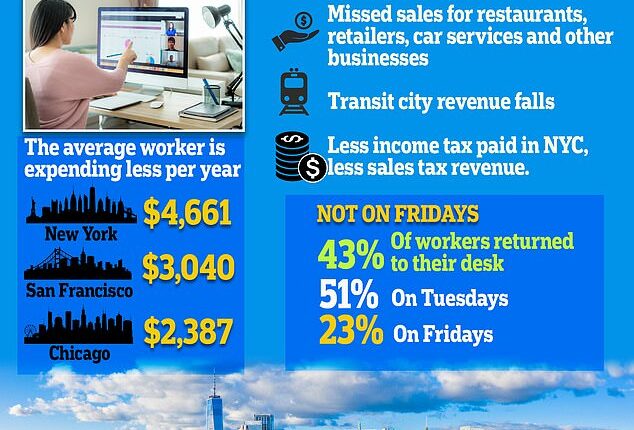Remote work is costing New York City $12.4billion per year as employees spend about 30 percent fewer days in their Manhattan offices than they did before the pandemic.
That staggering number largely comes from Manhattan employees who opt to stay home not spending money on food and entertainment at businesses around their offices, amounting to thousands of dollars per-person which would have previously been pumped into local economies going unspent.
Those lost sales are also depriving the city of valuable tax dollars, leading to crises in NYC’s budget that has infrastructure like the transit system – also struggling from lost commuter fares – in dire jeopardy.
Though the problem is present in cities across the United States, the situation is particularly pronounced in New York City, which has seen daily sales on certain days as much as ten percent lower than in other cities, according to Bloomberg.
Even as some offices have seen employees return in stronger numbers Tuesday through Thursday, in Manhattan commuters remains sparse on Mondays and Fridays, leading to a staggeringly low percentage of sales on those days as compared to 2019.


The Wall Street subway platform deserted on a on a Friday. Offices are still sparse on Fridays
In New York City, work from home has led to workers spending $4,661 less per-year on average on food, shopping, and entertainment in their offices’ neighborhoods.
Those numbers are far higher per employee at major cities across the country, including Chicago, where workers are spending $2,387 less per-year, and $3,040 in San Francisco.
While general spending has gone up across the country from 2019, on Mondays and Fridays in Manhattan remain paltry compared to the rest of the country.
Spending in the US on Mondays has gone up nearly 25 percent since 2019, but in Manhattan it is up just two percent. On Fridays across the US spending is also up just under 25 percent, but in Manhattan it is up only 11 percent, according to Bloomberg.
Those numbers are stronger in New York City outside of Manhattan. While spending on Mondays is up just 2 percent in Manhattan, the Bronx has seen a 28 percent increase, Queens has seen a 21 percent increase, and Brooklyn is up by 18 percent. And on Fridays, greater New York City has seen a 20 percent increase in spending.
Even with stronger figures for the outer boroughs, the city on the whole suffers from the significant loss in tax revenue from Manhattan.
‘If less income tax is being paid in New York City,’ Comptroller Brad Lander told Bloomberg, ‘then it’s hard to figure out how to capture enough value to maintain the subways and invest in the schools and keep the city safe and clean and all the things that really matter.’
Last year, NYC Mayor Eric Adams mandated all city workers return to the office for five-day work weeks, and plead with the rest of the city to do the same.
‘It’s time,’ he said last year. ‘New York City can’t run from home.’


Commuters on the Wall Street subway platform on a Tuesday morning, when officers are fuller
On average, by the end of 2022 offices attendance across New York City had only reached 43 percent of its level before the pandemic struck.
Tuesdays saw some of the highest levels of occupancy during the week at 51 percent of pre-pandemic levels, while Fridays saw a drop-off to 23 percent.
Bloomberg found that across eight of Manhattan’s most prominent office buildings, foot traffic was down 45 percent from pre-pandemic levels on Mondays, and 52 percent on Mondays.
With those still diminished numbers, experts say real estate value could drop up to 40 percent, costing about $5billion in lost taxes. That amounts to about percent of the city’s annual budget.
Adding to those troubles is subway ridership, which has only reached 64 percent of its pre-pandemic levels. That loss is expected to translate to $2billion per year in fare losses through 2026.
‘That’s a big hole that will need to be plugged with new taxes, lower spending,’ Professor Stijn Van Nieuwerburgh of Columbia University told Bloomberg.









